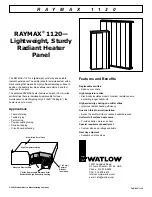
1. Description
The Swimming Pool SPA Heater consists of a heating tank with external enclosure, and the
electrical heating and control system. In order to help maintain the heater in a satisfactory
manner, a brief description of its components and their operation is included for the
customer’s convenience.
The pressure vessel and its enclosure comprise the main mechanical portion of the pool
heater.
The pressure vessel, in conjunction with the flow switch and heating element are the only
portions of this equipment in contact with the water.
The external enclosure is a sheet steel case totally enclosing the pressure vessel and
electrical components. The enclosure is coated with a rust inhibiting, powder coat finish.
The electrical system, which is the heart of this unit, can be considered as three separate
systems engineered to provide optimum use of energy. They are as follows:
(1) The heating elements; mounted on a four-bolt flange. There are 2, 3 or 4 elements.
(2) The control system; consists of the pilot switch, high limit thermostat, flow switch,
temperature control. These controls are wired into a control circuit designed to control the
temperature of the water leaving the heater. The high-limit thermostat is designed to open
the control circuit and cut off the power in the event of excessive temperature.
A flow switch is built-in to prevent the pool heater from operating without water flow. The flow
switch will activate at flow rates of 76 LPM (20 GPM) or greater.
INSTALLATION
2. Location
Hidrotermal SPA Heaters are quiet, do not expel exhaust fumes, and may be conveniently
located in a shed or basement. It should be securely mounted to a smooth, flat surface.
Normal positioning of the pool heater should be in close proximity to the pool filtration. Select
a location conveniently close to incoming electrical service and where excessively long
piping runs are not required. Leave minimum clearance of 9 inches/ 230mm on the lift, 12
inches /310mm both above and to the front and 6 inches / 153mm on the back for service
entrances and access.
3. Plumbing
Pipe the heater as shown in Figure 1 to the inlet and outlet openings on the right side.
Connect the heater in line between the filter discharge and pool. The water line coming from
the filter should be connected to the heater inlet, and the discharge line to the pool should be
connected to the outlet. The pool will not heat properly unless it is plumbed correctly. If
plastic pipe is used, it should be suitable for at least 120
℉
(49
℃
).
A plumbing bypass around the pool heater is not necessary unless flow rate though the
heater exceeds 303 LPM(80 GPM). A minimum flow rate of 76 LPM(20 GPM) is required.
Lack of sufficient flow will not allow the flow switch to activate the heater.
It may be necessary, in larger Olympic-sized or public pools, to use two or more heaters to
obtain sufficient KW capacity. If so, the heaters must be placed in parallel, so that each
heater takes equal flow.
DRAINAGE: A method of draining water away from the heater and other equipment is to be
provided. The heater should be flushed at the end of each swimming season. During
flushing or service, water may be spilled and could cause damage to the floor or other
equipment. A drain valve is to be installed in the INLET plumbing.
Содержание Hidro-H11
Страница 1: ...SPA HEATER USER MANUAL ...




























